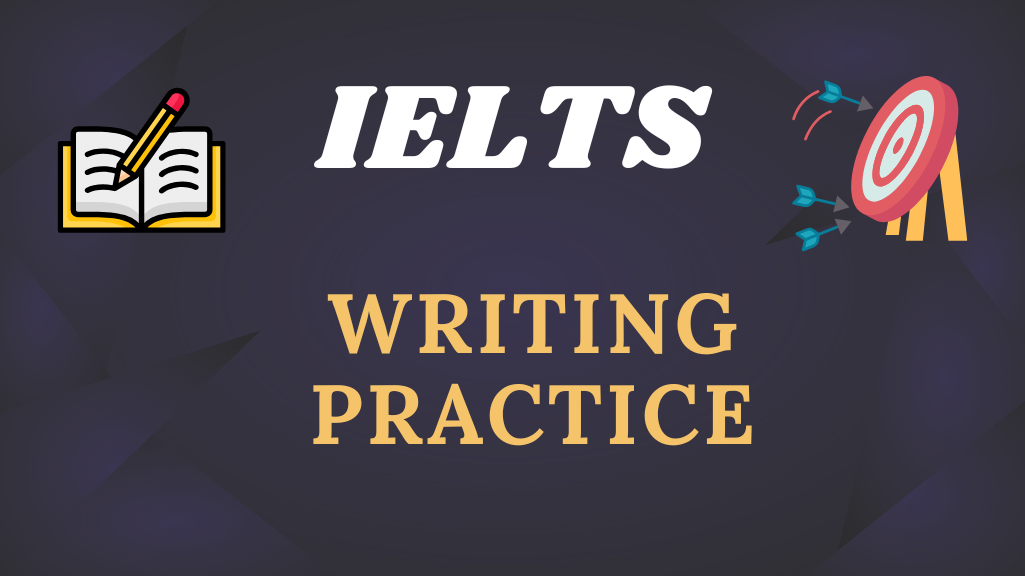The IELTS Writing test is a crucial component of the exam that evaluates your ability to communicate ideas effectively in written English. The Writing test consists of two tasks, each requiring different skills and approaches. Task 1 involves describing visual information (graphs, charts, tables, or diagrams), while Task 2 is an essay that presents an argument or discusses a problem.
To perform well, candidates must meet specific assessment criteria, including task achievement/response, coherence and cohesion, lexical resource, and grammatical range and accuracy. Let’s break down each task and provide sample responses to help you prepare effectively.
IELTS Writing Task 1
Overview
In Task 1, you will be given a visual representation of information, such as a graph, chart, table, or diagram. Your job is to summarize and describe the key features in at least 150 words within 20 minutes. You should:
Identify key trends and comparisons.
Summarize the main points without unnecessary details.
Use an academic or semi-formal tone.
Assessment Criteria
Task Achievement: Addressing all aspects of the visual data clearly and accurately.
Coherence and Cohesion: Organizing ideas logically with appropriate linking words.
Lexical Resource: Using a wide range of vocabulary accurately.
Grammatical Range and Accuracy: Demonstrating varied sentence structures and correct grammar.
Sample Task 1 Question 1:
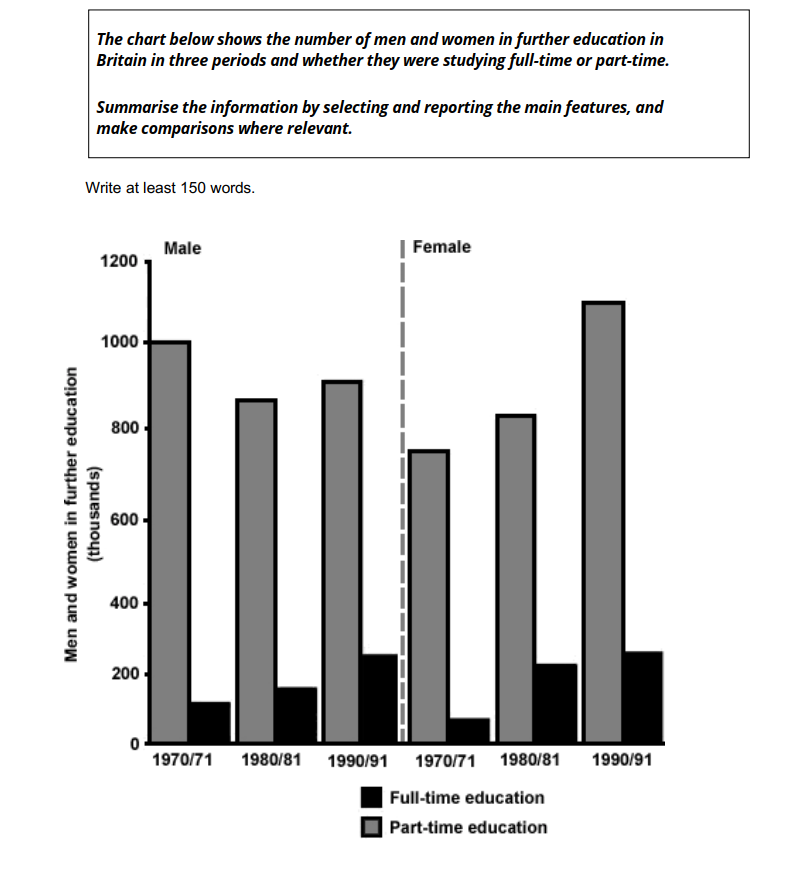
Sample Response
The bar chart illustrates the number of men and women in further education in Britain during the academic years 1970/71, 1980/81, and 1990/91, distinguishing between full-time and part-time study.
Overall, part-time education was consistently more popular than full-time education for both genders across all three periods. However, notable changes occurred in enrollment patterns, particularly among women, whose participation in further education increased significantly over time.
For males, part-time education remained relatively stable, with around 1,000,000 students in 1970/71, a slight decline in 1980/81, and a recovery to similar levels in 1990/91. Full-time education for men, on the other hand, saw a gradual increase from approximately 100,000 in 1970/71 to nearly 200,000 in 1990/91.
In contrast, the number of females in part-time education exhibited a significant rise, starting at around 700,000 in 1970/71 and surpassing 1,000,000 by 1990/91. Their participation in full-time education also grew steadily from a lower base of about 50,000 in 1970/71 to approximately 200,000 in 1990/91.
In summary, while part-time education was consistently preferred, women showed remarkable growth in both full-time and part-time enrollment, indicating a shift towards greater female participation in further education over the two decades.
Sample Task 1 Question 2:
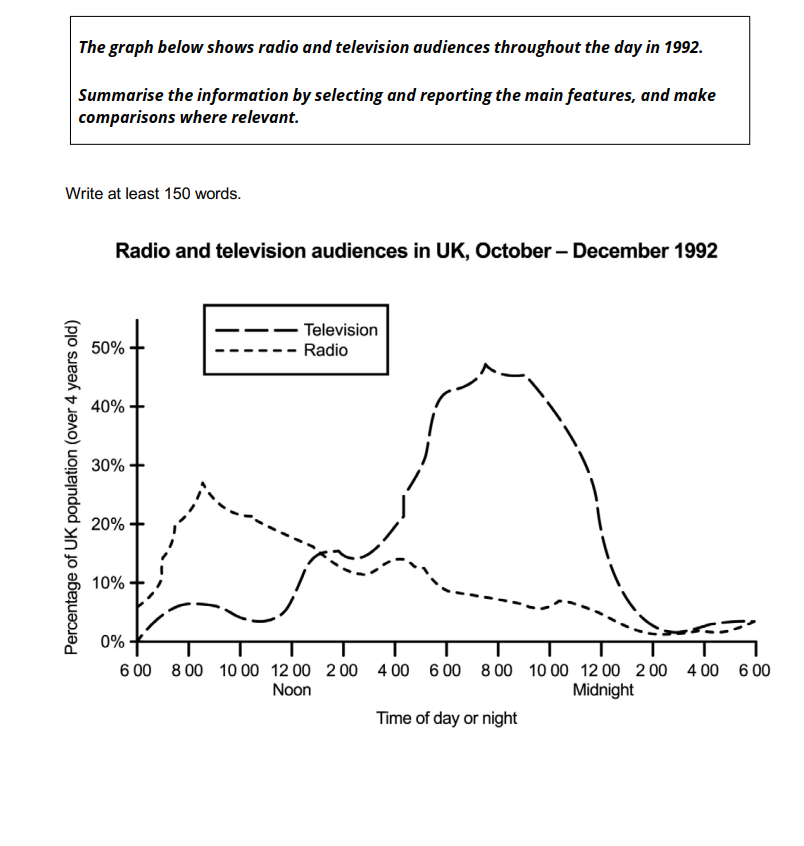
Sample Response
The line graph illustrates the percentage of the UK population aged over four years that listened to the radio and watched television at different times of the day from October to December 1992.
Overall, radio audiences peaked in the morning, whereas television viewership reached its highest point in the evening. Radio had a steady but moderate audience throughout the day, while television viewership saw a dramatic rise in the evening before declining late at night.
In detail, radio listening increased sharply in the early morning, reaching its highest point at approximately 8:00 AM with around 25% of the population tuning in. After this peak, the percentage gradually declined for the rest of the day and remained below 10% after 6:00 PM.
In contrast, television viewership remained low in the morning but began increasing significantly after 4:00 PM. It peaked at around 8:00 PM, when over 45% of the population was watching. After this peak, television audiences declined steadily and dropped to nearly 0% by 2:00 AM.
In summary, radio was more popular in the morning, while television dominated the evening hours, highlighting different viewing and listening habits throughout the day.
Sample Task 1 Question 3:
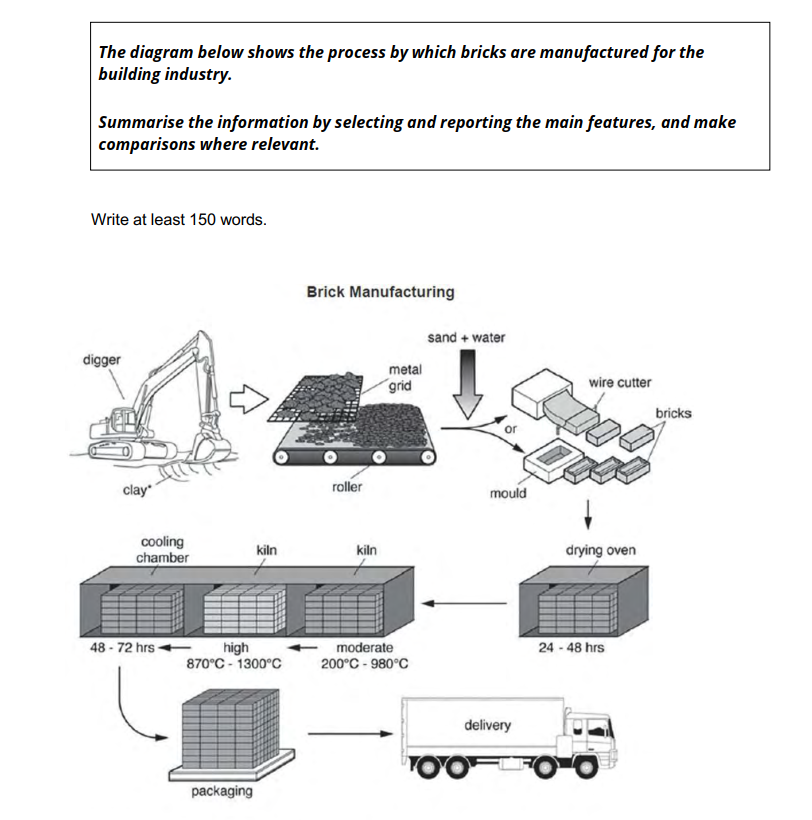
Sample Response
The diagram illustrates the step-by-step process involved in manufacturing bricks for the building industry.
Overall, the process consists of seven main stages, beginning with clay extraction and ending with the packaging and delivery of the final product. Various techniques and heating processes are used to shape and harden the bricks before they are ready for use.
Initially, clay is excavated from the ground using a digger. The clay is then placed onto a metal grid, which filters out any unwanted particles before passing through a roller. Next, sand and water are added to the clay to create a smooth mixture. This mixture is then shaped into bricks either by placing it into a mould or cutting it with a wire cutter.
The freshly formed bricks are then transferred to a drying oven, where they are left for 24 to 48 hours. Following this, they go through a two-stage heating process in kilns: first, they are exposed to moderate temperatures of 200°C to 980°C, and then to high temperatures ranging from 870°C to 1300°C. Afterward, they are cooled for 48 to 72 hours in a cooling chamber.
Finally, the bricks are packaged and loaded onto trucks for delivery to various construction sites.
In summary, brick manufacturing is a systematic process that involves shaping, drying, heating, and cooling before the final products are packed and distributed.
Examiner Guidance on Task 1
Based on the examiner comments, the following key aspects are what they look for when assessing IELTS writing tasks:
Content and Task Achievement:
- The response must address all parts of the task and provide relevant details, such as referring to specific figures or data in the case of graphs or diagrams.
- A complete and accurate overview is important, especially when describing processes or trends. This includes mentioning key stages or summarizing key features of the task.
Coherence and Cohesion:
- The ideas should be logically organized and easy to follow.
- Good use of cohesive devices (e.g., conjunctions, referencing) to link ideas together is necessary.
- The message should be clear, and transitions between sentences and paragraphs should flow smoothly.
- Effective paragraphing is important for clarity and ease of understanding.
Language Use (Lexical Resource):
- A wide range of vocabulary should be used, with flexibility and accuracy.
- Vocabulary should be varied and appropriate for the task, without repetition.
- Minor errors in word forms or expressions may occur, but they should not hinder communication.
Grammatical Range and Accuracy:
- Complex sentence structures should be used to demonstrate language proficiency, but they should still be clear and easy to understand.
- Grammatical accuracy is important, though minor mistakes might not significantly affect communication.
- Efforts to use more complex structures should be successful and not cause confusion.
Clarity and Expression:
- The writing should be fluent and sophisticated, demonstrating the candidate's command of language.
- There should be minimal errors in punctuation, spelling, and grammatical structures.
- Sentences should be varied in structure, and language should be natural and effective, though some awkward or clumsy phrasing may still appear in lower-level responses.
IELTS Writing Task 2
Overview
Task 2 requires you to write a formal essay in response to a given topic. You must write at least 250 words within 40 minutes, presenting a well-structured argument with supporting evidence.
Assessment Criteria
Task Response: Fully addressing the task with relevant ideas and examples.
Coherence and Cohesion: Organizing paragraphs logically with clear transitions.
Lexical Resource: Demonstrating a rich and precise vocabulary.
Grammatical Range and Accuracy: Using complex sentence structures correctly.
Sample Task 2 Question 1:
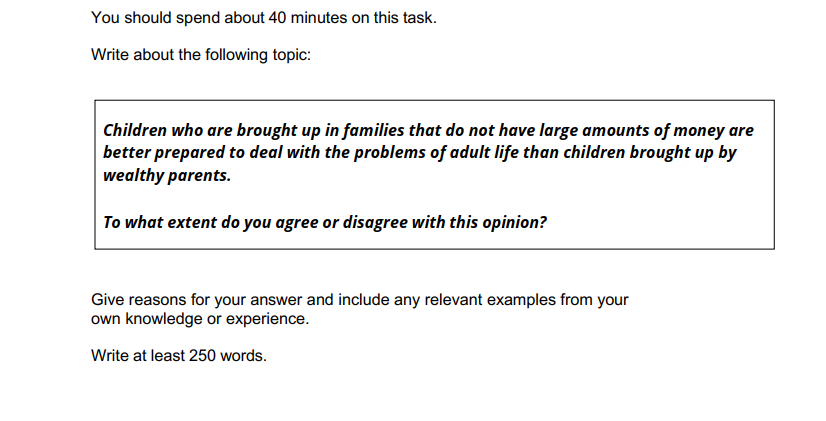
Sample Response
Children from financially modest backgrounds often develop resilience and adaptability, which can be advantageous in adulthood. However, wealthier children may have access to better resources and opportunities, which also contribute to their preparedness for life’s challenges. This essay will discuss both perspectives before concluding that upbringing, rather than financial status, plays a more significant role in shaping a child's ability to handle adult life.
One key advantage of growing up in a less affluent household is the development of problem-solving skills and financial awareness. Children from such backgrounds often witness their parents making financial sacrifices and prioritizing necessities, which teaches them budgeting and resourcefulness from an early age. For example, they may take up part-time jobs or learn to save money, habits that prepare them for managing their own expenses in adulthood. Additionally, they tend to develop strong interpersonal skills, as they rely more on community and relationships rather than material comforts.
On the other hand, children raised in wealthy families benefit from superior education, healthcare, and networking opportunities, which can provide them with a strong foundation for success. They have access to extracurricular activities, better schools, and mentorship programs that enhance their cognitive and social skills. Furthermore, financial security allows them to explore career paths without the immediate pressure of earning a living, enabling them to make more calculated and long-term career decisions.
Ultimately, financial status alone does not determine a child's ability to navigate adulthood. A supportive family environment that instills values such as resilience, independence, and responsibility is far more influential. While children from poorer backgrounds may develop these qualities through hardships, wealthier children can also acquire them through proper guidance and experience.
In conclusion, both wealthy and less wealthy upbringings have unique advantages in preparing children for adulthood. The key factor is not wealth itself but how parents nurture independence, perseverance, and responsibility in their children.
Sample Task 2 Question 2:
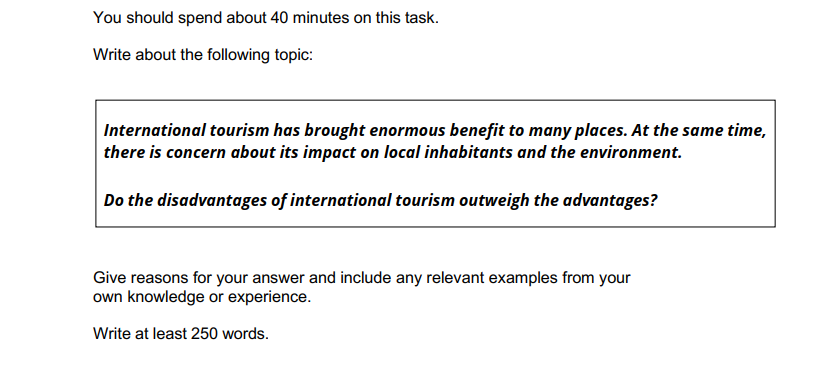
Sample Response:
International tourism has undeniably brought enormous economic benefits to many destinations. However, alongside these advantages, there are concerns about the impact it has on local inhabitants and the environment. In this essay, I will discuss both the positive and negative aspects of international tourism and argue that its disadvantages can, at times, outweigh the advantages.
One of the major benefits of international tourism is the economic boost it provides to local economies. Tourism generates employment opportunities in various sectors such as hospitality, transportation, and entertainment, helping communities thrive. For example, in many developing countries, tourism is a crucial source of foreign currency, which supports infrastructure development and public services. Additionally, it can lead to increased awareness of a region's culture and heritage, encouraging preservation efforts.
However, the negative consequences of international tourism cannot be overlooked. One of the most significant concerns is the strain it places on the environment. Popular tourist destinations often face over-tourism, leading to environmental degradation. For instance, historical sites and natural wonders are at risk of damage due to the sheer volume of visitors. The degradation of ecosystems, pollution, and waste accumulation are common outcomes of uncontrolled tourism.
Moreover, local communities can suffer from the social and cultural impact of mass tourism. The influx of tourists may lead to the commercialization of local culture, eroding traditional values and practices. Additionally, the rise in demand for goods and services may drive up prices, making it difficult for local residents to afford basic necessities. In extreme cases, the displacement of local populations to accommodate tourists has been reported, creating social tension and inequality.
In conclusion, while international tourism offers significant economic benefits, its negative impact on the environment and local communities cannot be ignored. If the disadvantages are not addressed through proper management and regulation, they may outweigh the advantages, causing long-term harm to both the region and its inhabitants. Therefore, it is crucial to strike a balance between promoting tourism and protecting local interests.
Examiner Feedback on Task 2
Based on the feedback from the examiner, here's a more concise breakdown of what they are looking for in Writing Task 2:
1. Task Response
- Clarity and Relevance: Make sure your answer directly addresses the question. Your position should be clear throughout and your ideas should be relevant, well-developed, and backed by examples.
- Comprehensive Development: Don’t just touch on points; explore them in-depth. Avoid over-generalizing, and ensure that your points flow logically.
- Avoid Copying: Don’t simply repeat words or phrases from the question prompt. Paraphrase effectively to demonstrate originality.
2. Coherence and Cohesion
- Organized Structure: Present your ideas in a logical sequence. Each paragraph should tackle a single idea, and your arguments should be easy to follow.
- Paragraphing: Use paragraphs appropriately, balancing length and focus. Overly short or long paragraphs can impact clarity.
- Linking and Referencing: Use cohesive devices (like "for instance," "in contrast," "therefore") naturally to connect ideas. Avoid overuse, and make sure transitions are smooth.
3. Lexical Resource
- Vocabulary Range: Your vocabulary should be varied, precise, and contextually appropriate. The better your word choice, the clearer your message.
- Word Flexibility: Demonstrate your ability to modify and combine words effectively. For example, using different forms of the same word (e.g., "succeed," "successful") can show flexibility.
- Accuracy: While variety is important, it’s also crucial to use the right words. Avoid common vocabulary errors and strive for accuracy in word choice.
4. Grammatical Range and Accuracy
- Sentence Variety: Aim for a mixture of simple and complex sentences. Using subordinate clauses and different sentence structures will show grammatical variety.
- Error-Free Writing: While occasional mistakes are fine, frequent errors in punctuation, grammar, or spelling can lower your score. Try to minimize them.
- Consistency: Make sure your use of tenses and sentence structures is consistent throughout the essay. Random errors may confuse the reader and lower your score.
What Makes a High Band Score?
- Band 8.5: Clear, in-depth analysis with sophisticated organization and excellent use of vocabulary and grammar. Only a few minor errors.
- Band 7.5: Strong response with good organization, varied vocabulary, and mostly accurate grammar. Minor punctuation or structural errors.
- Band 6.5: Ideas are developed but might be unclear or generalized at times. Some issues with organization or grammar.
- Band 5.5: Response lacks clear development or coherence. Frequent errors in spelling, grammar, and punctuation hinder clarity.
